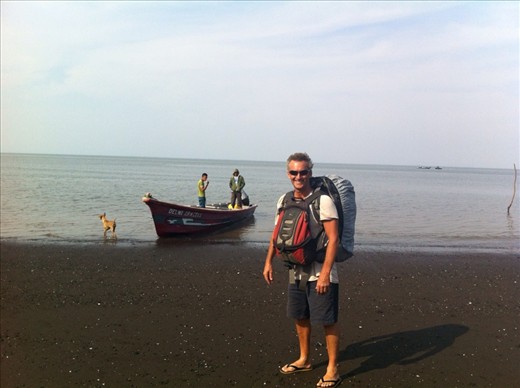
Nica
We land on a deserted beach with an abandoned boat pier alongside. "Is this Potosi?" we ask the boatman. "Si" ...yep we have landed in Nicaragua. Just the two of us.The immigration office is a short walk up a track, no one around, stinking hot! The immigration official comes out of the shadows and checks our passports, we pay our $12, and we are allowed to enter the country. Of all the CA4 countries (Guatemala, Honduras, El Salvador and Nicaragua) this was our most expensive border crossing. Most are a couple of dollars or often nothing at all.
As it is getting late, we spend our first night in Nicaragua here on Potosi at a small family run guesthouse a couple of hundred metres down the road. It looks like the only choice we have. Straight away we sense a more relaxed vibe in this country. Reminds us of some of our favourite SE Asian countries, like Laos or Cambodia. Unfortunately, poverty is prevalent. Fishermen provide the basic income for families. Women work tirelessly behind the scenes. Children follow their parents stereotypical roles. Girls help their mothers, care for younger siblings, and often fall pregnant at a young age. Boys are generally lazy, hoping to become fishermen one day and quite often fall victim to the bottle and become 'drunks' along the way!
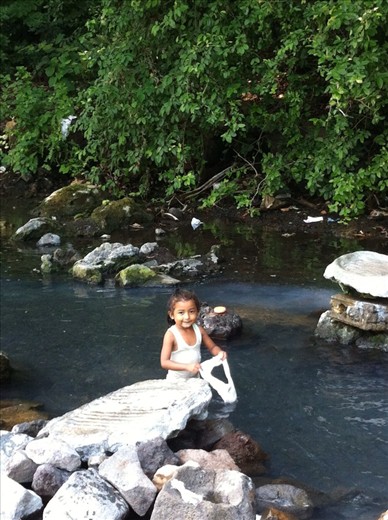
We spend our first few days on the coast near Jiquillo, a small fishing village with a relaxed hostel called Rancho Esperanza. Leeanne and I celebrate our 'one year' anniversary here. Can't believe we have been on the road for a year! So many places, so many adventures!
Who would have thought 365 days, 12 months, 15 countries, hundreds of different beds, tens of thousands of kilometers and still we haven't hit the wall. It has helped that we were able to spend incredible quality time with our beautiful family, visits from dear friends and a quick visit to oz to recharge the emotional batteries! In the words of a great man " our gratitude cup floweth over"!!!
Our new hostel friends are more than happy to share a beer or two with us as we watch the sunset in the Pacific. Australia is over the horizon somewhere. I'm lucky enough to get a fun 2-3foot surf right in front of our hostel. Remains of former buildings are in the water. A recent tsunami wiped out 6 blocks of houses and pushed the coastline back hundreds of metres. It's amazing how many disasters have happened here which barely register in Australia. Leeanne spends her time reading. With the large library the owner has built up, she has plenty of books to choose from and for something a little more strenuous she relearns to hula hoop. "Good for the waistline" I tell her. Lying around in hammocks occupies much of our time. I borrow a machete and cut open coconuts when I get bored or pick up a guitar and have a strum. I even sing "Seagull" to our new friends. Most of them weren't even born when I wrote the song back in 1979. It still brings a smile to many faces! There are some talented musicians here. We walk 5 km along the beach to the next village, it feels very remote here. Fishermen, dogs and people lying around in hammocks doing little.
A few days later we make our way to Leon. A simple trip lasting no more than 3 hours but lots of bus/taxi changes to reach our hostel, chosen because it has a pool....bloody hot here!
Leon is an easy town to walk around, although the unbearable heat restricts our sightseeing to mornings or late afternoons. The cathedral is awesome, being the biggest in Central America, its easy to find in front of the parque central. Street food is excellent, plus we manage to make our own granola, fruit and coffee each morning for breakfast. We only have 2 cups so its usually a 'cuppa' first, followed by granola in a cup, then another coffee to wash breakfast down. Our electric hot water element gets plenty of use ( this is number3, as we the first one self destructed and lost the second). We leave Leon, after learning a little more about the town's revolutionary past, with heroes and martyrs remembered in museums. Time to escape the heat as we head up into the hills of Esteli. We end up staying in this area for nearly 3 weeks. Leeanne does her research and we find a Spanish teacher in town. Norma, our host lets us stay at her house for the first week as she teaches us some more Spanish. 4 hour lessons per day, coupled with continual conversation, no English. Total immersion! Surely we have to improve! My Spanish is still really dodgy, but Leeanne is going great. She talks and understands general conversation well and seems to enjoy it, too! The experience at the home stay turns out to be much more than learning Spanish. We find ourselves totally immersed in Nicaraguan life. Norma's house is unique, as she lives alone, but has a constant stream of people visiting, staying, eating, cleaning, you name it! She has opened her house to many locals wishing to improve their education. Norma's passion is education. Most nights, after a full days work at home she walks to a local school or uni and teaches more classes. Some nights she studies herself to further her own education. An inspirational woman, with liberal views and ideas, trying to stay one step ahead of traditional warped Nicaraguan values. She reads and learns as much as possible about our western way of life, hopefully to help improve the lives of those around her. The streets here are mostly rocky, dusty with little vegetation. The sound of dogs barking, roosters crowing, bus horns in the distance, someone riding by on a bicycle through the gravel street is what I here as I wake every morning inside our concrete bedroom. Norma's stamina is remarkable as she teaches us then feeds us amazing local food, cleans and fits in tourist sights as well. We visit cigar factories (homes with the garage full of tobacco leaves, one guy raking them up, in another room 2 guys rolling cigars by hand, and a girl collects finished cigars and packs them in bundles ready to sell, we are behind closed doors......locked doors, of course!), paper making workshops and two glorious days are spent in the mountains. On a visit to Tisey National Park we visit the finca of a 74 year old man Don Alberto who had a vision to carve sculptures into the rock ledges on his farm. 35 years later on his amazing pineapple/ coffee finca he still manages to guide the occasional tourist who make the 1km downhill hike over his farm as he points out all the organic produce and his amazing art works. We bring along a packet of cigarettes to give to him, apparently that's what he likes. He eagerly accepts the smokes, then proudly continues to tell us about his life, all in Spanish, of course.
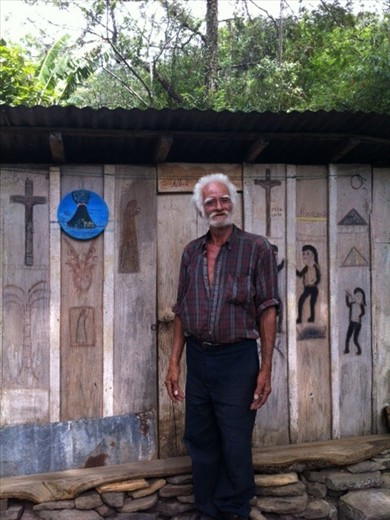
There are many incredible hikes around the area and on a visit to Serva Negra we manage to see howler monkeys, the national bird and hear the leopards roaring across the valley from their rocky hideouts. On the way back to Esteli we drop in to the
Sunday afternoon cock fights, not my cup of tea at all!
We say goodbye to Norma, promising to return in a few days time.
Other travellers tell us about this amazing place to visit nearby called Somoto Canyon. It turns out to be a highlight of our Nicaraguan adventure. The home stay we choose is right on the main road at the entrance to the canyon. A family of eleven live here. The 6 boys (all over 25 but seem much younger) work as guides into the canyon. The girls work at home cooking on the traditional open fire. Everything we eat is grown here on their farm. Our canyon trip was unreal! Trekking, climbing over river boulders, jumping off cliffs into water holes (some as high as 20 metres), swimming, floating down over shallow rapids. All the time we are enclosed within the walls of a gigantic canyon. Often the cliff walls are vertical reaching over 100 metres high. The gorge itself is sometimes less than 10 metres wide. Nowhere to hide if a flash flood heads our way.
Most people come here on day trips, we are lucky because we have time on our side so we decide to stay with the family for 3 nights, enjoying the company of Mumma, Pappa and the 9 grown up kids. Leeanne gets a ride on a burro (donkey) owned by one of the boys. He is so proud of his 4 year old donkey and tells us how he saved for ages to by a saddle for $70.
The boys have been bought up really well, as they are so polite and helpful. They still have that youthful 'cheekiness' about them. They are only allowed 2 beers a day each at home, they play up when they go to town!
We return to Esteli (minus a small backpack stolen on the chicken bus to Somoto Canyon...sorry Josh, your camera went. Some bloke pretended to be the bus conductor, found us seats and promptly took off with the bag) We again stay with Norma at her home for 2 nights before leaving for Masaya. Our last day in Esteli turns out to be action packed! A fair/ fiesta/whatever has arrived in town, bringing thousands to watch men and women on horseback parade down the streets. The horses are groomed, and the riders dressed in traditional clothes, as they prance and dance along the crowded streets. Brass bands seem to compete with the modern Latin music blasting out of large speakers in the back of utes. Everyone is drinking cans of beer, lots of it. As we walk along with the parade, finishing our third beer we start to sense danger. The crowd is getting really wild, the music really thumping, horses knocking us over, fights in the street. Time to get out of there and head back to our quiet home stay. What an experience! They don't have parades quite like that at home.
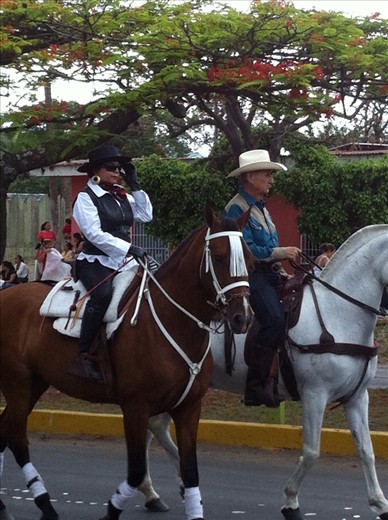
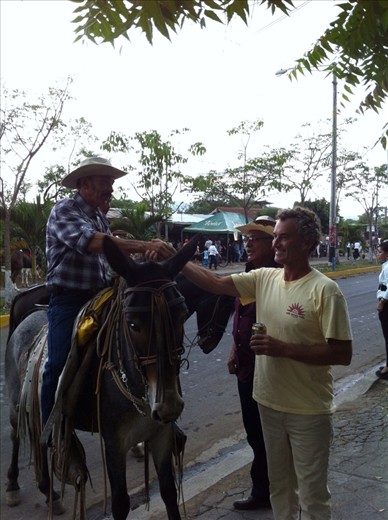
One thing about Nicaragua is the genuine character of the people. They are friendly but still reserved. It only takes the smallest of eye contact to make some sort of connection......mostly positive. We practice our Spanish with the locals every day. Some days we speak no English....just me and Leeanne. You kind of get used to it after a while.....but when you get together with other English speaking travellers you kind of let loose. Exchange travel tips, tell adventure stories (exaggerate a little to scare the shit out of them) , have a couple of beers with them and eventually say 'adios'. You really do meet some amazing people travelling, all ages, all nationalities, all with their own take on life, all of us moving like ants around the globe.
Masaya gives us our first taste of the wet season. It is the end of May 2013. Storms build every afternoon producing torrential rain for a few hours or nothing at all. Finally got to see a baseball game. We are the only gringos in the crowd, drinking beer and eating many of the tasty snack foods prepared by the local women wearing their trade mark aprons.
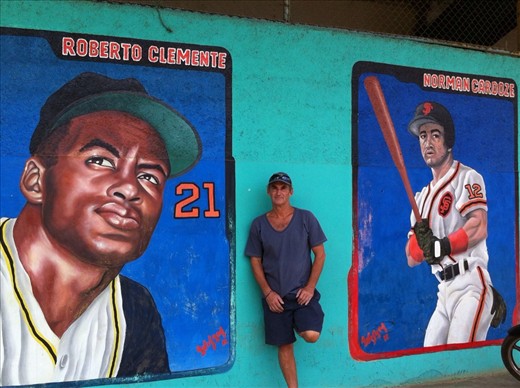
A storm approaches before the end of the game so we make a dash back to town, just making it to a restaurant near our hostel before the skies opened up. The streets flood within an hour. Everything is clean and fresh the next morning. The highlight of Masaya was our trip up the local volcano, it is active and still very dangerous. You are only allowed to stay at the top and look into the sulpherous smoke filled crater for 10-15 minutes before they send you back down. The smell of sulphur is often overpowering. Only 6 months ago a small eruption threw thousands of tennis ball size rocks across the top directly onto the viewing spot. The plastic orange safety hats they make you wear wouldn't help much I don't think! The countryside around the volcano is covered with dark jagged rocks, remnants of lava flows from eruptions 300 years ago. Geologists and scientists spend a lot of time in this region. If you love volcanoes, active ones, Central America is the place to come.
We head down to the bus terminal, and wait (as patient as possible) for a chicken bus to Laguna Apoyo. It is stinking hot, we are dripping with sweat, and open mud filled, rubbish infested bus terminal at Masaya is one we are glad to leave.( an interesting observation here as many times we have been in the same situation and loved the vibe, today we were hot and cranky) Our home for the next 4 nights is Paradiso on the lake edge of beautiful Laguna Apoyo. An extinct volcano crater with crystal clear fresh water rimmed with tropical rainforest, hosting a few species of fish found only here in the world. Some are yet to given names! We meet some really cool backpackers here, and the new owners, a young French couple, make our stay here comfortable and chilled. They have free kayaks to use plus a couple of tubes to float around in. The water temperature is perfect, the beer is cold the scenery breathtaking. The jungle is all around, and we share it with countless birdlife and families of howler monkeys that let out this amazing 'howl' each sunrise and sunset. We don't need an alarm clock to get up before
6am.....the monkeys do their job! One day we volunteer and join a local organisation trying to create environmental awareness, through rubbish collection and promoting clean habits to the local community. We walk along rainforest tracks, filling bags with rubbish, practicing our Spanish with local kids, as we take in this amazing countryside we are in. Nicaragua is fast becoming one of our favourite countries.....it seems to tick all the boxes as a budget travel destination.
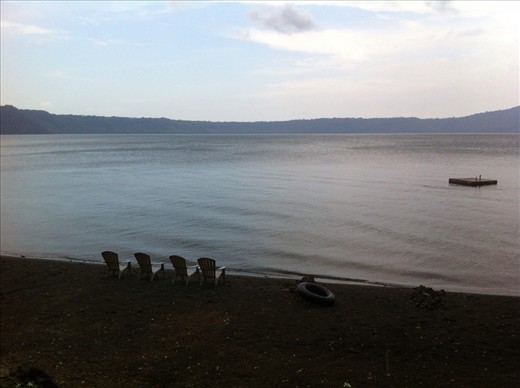
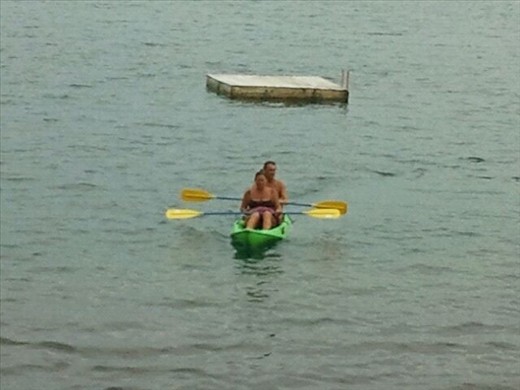
We leave Laguna Apoyo, and after lots of fresh water swimming we are really clean and so is the lake. It's time to head down to the Pacific coast in search of some waves and salt water, but first we need to see the town of Granada. We book into the Oasis Hostel and get a reasonable room with fan. Free, all you can eat pancake breakfast, is a bonus. The colonial town of Granada is popular with tourists. Beautiful colonial buildings and architecture, coupled with its revolutionary history, make it an interesting place to see. It's easy to walk around and see most sights on foot. Exploring the ropa segunda ( op shops) we find some bargains for 10 c each or under 50cents.
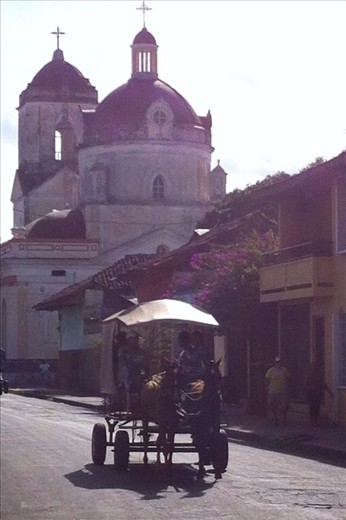
A couple of days here is enough for us and we make our way to San Juan Del Sur, the surfing centre of southern Nicaragua. First impressions aren't great as a huge swell has made the bay and beach area really filthy with logs, debris and rubbish. There are quite alot of Surfers here many from the US and Canada. It is so hot but we don't risk swimming here because of the dirty water. We settle into our accommodation well. An old historic pub overlooking the bay. We jag the upstairs balcony room and spend lots of spare time sitting on our balcony watching the world go by while sipping on rum and cokes. 4 days later we are still doing the same thing. We are starting to like the place. The swell has dropped off a bit, the water has cleaned up and the waves are good. I borrowed a nice longboard off an American guy. It felt good to ride a decent board. So many of the rental boards a dodgy. They have usually been snapped at least 3 times, repaired, lots of dings, fins missing, you name it!
We take the daily shuttle out to explore the local beaches everyone is raving about. Playa Maderas is about 20 minutes north through lush countryside. The main break is nice and has good waves but the real star here are the beaches that lay to the north. Walking around the rocks we discover magnificent white beaches and rocky headlands. There are some great places to stay at Castaways or Matilda's. We enjoy the swimming and eating mangos and papaya straight from the trees. Never seen so many mangoes, ever! Walk along and pick one up, have a chew, sometimes skin and all, keep eating mangoes, all for free!
There is a bit of a traffic jam back in town and we discover that the Dakine world juniors ISA surfing titles are on and there is a parade of all the surfers. First ones we spot are the ubiquitous green and gold uniforms con Akubras. Bleach blonde larrikins busting with excitement. An afternoon shower doesn't dampen their spirits and we get talking to a few Aussie parents following their kids. Eli Stone and Matt King are two names to follow in the future. What a thrill for them to be representing their country surfing in Nicaragua, so far from home, and so so different.
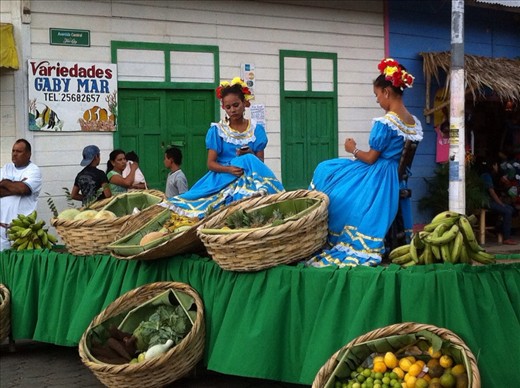
Time is starting to run out for our visa stay in Nicaragua. Only 2 weeks left. So we leave the coast and make our way towards Costa Rica. First, we must see the famous Ometepe. Imagine two volcanoes joined together sitting in the middle of a huge inland lake. Check it out on a map, it is a huge landmark here in Nicaragua. We catch a chicken bus, taxi, ferry across to the island landing at Moyogalpa, the main port town of Ometepe and two more chicken buses. We have already done our research and decided to stay on a permaculture farmstay called Zopilote. A little bit alternate with free yoga each morning, amazing fresh food, salads and whole grain breads we haven't had for a long time. We visit Ojo de Agua, beautiful clear swimming pools in a rainforest setting. The whole island is an abundance of nature growing wildly. Both volcanoes here have tracks up and manageable to climb, but expect a hard slog for the best part of a day. Volcan Concepcion, the biggest, takes at least 8-10 hours up and back. It is constantly active and ready to erupt again one day, just not sure when! The. Transport system is pretty dodgy here every time we ask what time the bus is coming we get a different answer but eventually after an hour or so one way come.

We leave Zopilote on a sour note. Leeanne's mobile phone is stolen from our room the day we plan on leaving, and we try our hardest to insist that it is only another material possession but this hurts.. It's our main communication link to the kids and home. Paul offers rewards, going and speaking to gardeners etc. we have lost our two cameras in two weeks now and are reduced to the dodgy underwater camera that may or may not turn on depending on its mood.
We wait for a bus that doesn't arrive so have to pay $12 for a taxi to a secluded port, for a ferry that changed its timetable so we wait 5 hours with a French couple playing the universal traveller card game of shithead.
At 9 pm we are on the night ferry to San Carlos. We are assigned the upstairs room ( double the price to $6 lol) long padded benches, quite cosy and the only ones here. I actually sleep through the night much to my surprise and we wake
at 5 am in the remote south eastern corner of Lake Managua where the Río San Juan runs from the lake to the Caribbean. It is a historic day as this very day Nicaraguan parliament approves a Chinese plan to build a canal in this very area. Most people are not happy as they believe they will benefit little and the environment will be adversely affected forever. 10 years from now this place will be so different. With a new canal connecting the Atlantic and Pacific, so many large cargo ships will pass through Nicaragua. With the Chinese in control expect to see lots of concrete and environmental damage!
After a huge $2 breakfast on the riverfront in San Carlos watching the town awake we take another small boat down stream for 3 hours to El Castillo. A beautiful little village with a fabulous fort guarding the bend from pirates and invaders. No road acces means no cars, nor motorbikes it is quite save the roar of rapids under our veranda.
The French couple are here too and we team up with about the only other tourist in town a Swiss NGO worker for a rainforest tour. Note RAIN ..... Lol poison dart frogs in bright colours of red and green, killer mosquitos, killer thorns, killer ants and mud to our knees. Thank goodness they insisted on us renting gumboots haha.
All in all we struggle with these sort of trips. We know at home we can do similar walks for free in many parts of the country. But a guide is handy to find and identify the finer details of the forest even if it is all in Spanish.
El Castillo is our home for a couple more days. We explore the town on foot. No roads, no cars, not even a motorbike to be seen. Only the odd "pushy" horseback riders. The old fortress is a must to visit. $2 entry gives you a fantastic view of the town overlooking its river and rapids. We discover that many pirates tried to pass this spot, including Lord Horatio Nelson, Dampier and Henry Morgan. Funny, I'm sure at school we were taught that these guys were famous explorers, not 'pirates' !
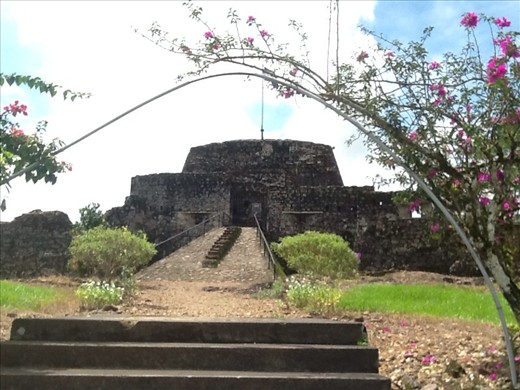
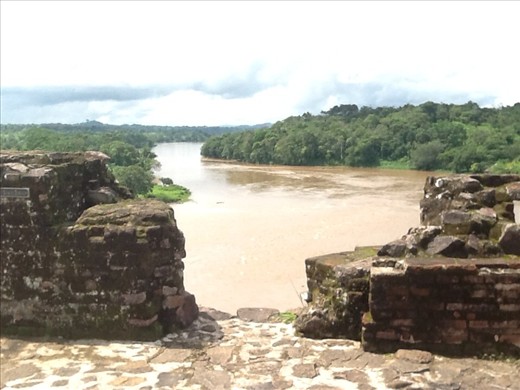
It's Sunday and many locals are at church listening to the Evangelist Minister going hard. Some older locals are relaxing in rocking chairs chatting to those that walk by. Some men are drinking 1 litre bottles of beer with mates and talking noisily. I watch as the soccer players pass by on their way to the local footy field. I follow them and get entertained with a great game of soccer. Talk about local rivalry. In front of a reasonable crowd these guys played hard. Skill level was pretty good, too. Craziest thing was when the ref blew full-time, nobody shook hands. They all simply picked up their bags and walked off home. The field was deserted within 10 minutes. Not even a post game beer! Not like home.
We keep stalling on entering Costa Rica. We can see it, so close, but we know once we leave Nicaragua the costs are going to skyrocket. It will be a real test for "Cheapskate Tours", which so far our budget has been pretty much on track. Our total costs per day are still around the $45. Still a bargain by anyone's standards. During our last week in Nicaragua we have been surrounded by jungle with no roads or motorised transport, no Internet, very little electricity, only boats. We head back to San Carlos on the morning ferry and promptly take the afternoon boat to the Solentamine Islands. Very remote cluster of islands. Only a handful of people live on San Fernando Island. It rains at some time on most days with humidity levels really high. This region on the bottom edge of Nicaragua Lakeand is unique. The many species of bird life, howler monkeys, crocodiles and bull sharks add to the ecosystem to the point you feel totally isolated from civilisation. 3 nights here was great. I could live here if I could buy one of the small islands, some of which are up for sale, and cheap! We headed out on a fishing trip here with local boatman, Jose. Within half an hour I caught 3 fish, one a real beauty about 1 kg. We ate it for dinner, so good.
We say goodbye to our island paradise and head back to San Carlos for our last night in Nicaragua. We find a clean guesthouse with comfy beds, no mosquitos, plus wi-fi. Finally a chance to contact the family and read the mail. We enter Costa Rica tomorrow by boat at the river border. We leave behind the beautiful country of Nicaragua. So diverse in may ways, with so much to offer the keen traveller. The people are genuinely friendly, landscape spectacular and costs minimal. Just days ago, however, the Nicaraguan government signed a deal with the Chinese. They plan on building a super canal connecting the Atlantic and Pacific. A huge project which will change the face of Nicaragua forever. Our island paradise won't be the same with countless cargo ships cruising by.